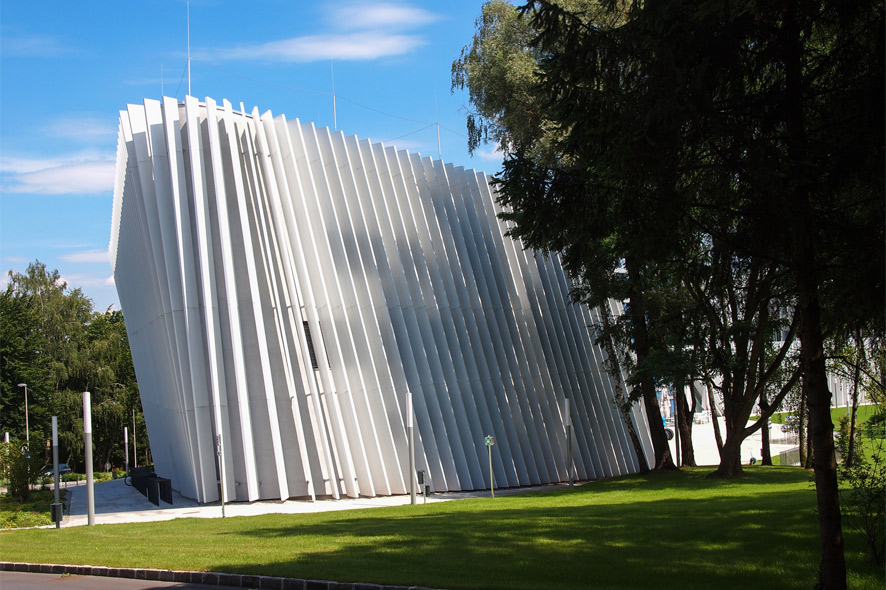Anton Bruckner Private University’s new building at the foot of Pöstlingberg in Linz has been open for less than a year and it’s already serving as one of the 2016 Ars Electronica Festival‘s prime venues for electronic music. Sonic Saturday on September 10, 2016 will be staged at the school’s Computer Music Studio (CMS) and thus in premises equipped with state-of-the-art media technology. The Sonic Lab and other spaces will be settings for concerts and hubs for artists, experts and listeners with a penchant for electronic music.
We recently met with Volkmar Klien, professor in the new Computer Music and Media Composition program, media artist Se-Lien Chuang and Andreas Weixler, director of the CMS, and talked about the Sonic Lab’s special features and possibilities. They also revealed what visitors can look forward to on Sonic Saturday at the 2016 Ars Electronica Festival.
The new university building features a concert hall especially for computer music! What led up to the decision to build the Sonic Lab?
Andreas Weixler: Just like the Ars Electronica Center got a makeover in 2009, I realized that we lacked a concert hall especially for computer music concerts. Se-Lien Chuang and I discussed this with Ars Electronica Artistic Director Gerfried Stocker and he offered the possibility of staging computer music events in the Center’s extraordinary new Deep Space facility. The upshot was “Sonic Intermedia,” a series of concerts and speeches produced jointly by the Ars Electronica Center and Bruckner University and featuring numerous international guests. The intermedial concerts was held in Deep Space, and the speeches and workshops at the Bruckner University’s CMS. But I was already making an effort to show that we actually need our own concert hall for computer music. “Sonic Intermedia” in 2009 was the first collaborative project in Deep Space—with its 5.1 loudspeaker system and a special, supplementary multi-channel system in conjunction with the fantastic 16-by-9-meter projection surfaces on the wall and floor. And it was followed by an almost annual series of concerts by international artists.
Volkmar Klien: Thanks to Andreas Weixler, we now have a Computer Music Studio that provides what a contemporary music university needs. This not only made possible the technical infrastructure that was installed and put into operation this year; it also carries on the 20-year history of electronic music at this institution. And in addition to this long history, since 2015 Bruckner University has also had its own Institute for Composition and Conducting, a further indication of the important status that the New Music genre has here. In addition to my appointment, Carola Bauckholt, a scholar with an international reputation, was named professor to round out our faculty. And our cooperation with Ars Electronica is another important step towards enhancing our worldwide reputation in the field of composition.
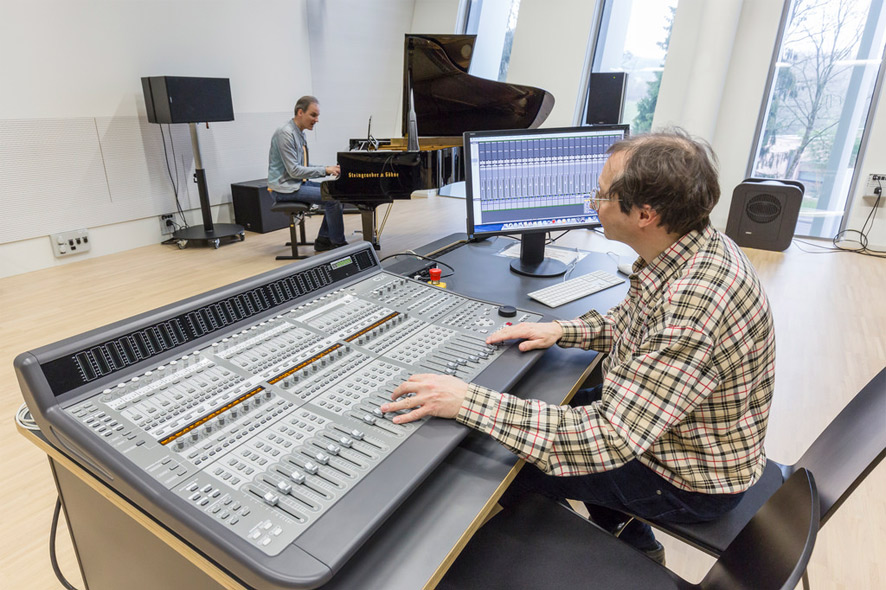
The mixing console of the Sonic Lab. Credit: Christian Herzenberger
Chuang Se-Lien: Numerous small steps led up to this quantum leap. In 2008, Andreas Weixler earned his post-doctorate degree in electro-acoustic music and computer music, supervised by a committee of in-house and outside experts. Then, he headed the CMS as an institution and competence center, and expanded the colloquium in conjunction with the bachelor degree program in computer music that was introduced in 2014. More than 10 years passed until the expanded premises for the CMS and an intermedial computer music concert hall were placed in operation—not least of all in conjunction with this institution’s advancement from a conservatory to a university, thus bringing to fruition the protracted efforts of many deans and the entire faculty. This Sonic Lab does justice to Linz as a UNESCO City of Media Arts. Especially noteworthy is the expert advice we received from Gerfried Stocker, artistic director of Ars Electronica, and Christa Sommerer, head of Linz Art University’s Interface Cultures program, in planning the New Media & Multimedia working group for a modern music university. After all, I’m an alumna and I’m intimately familiar with the 20+-year history of music & media technology and electronic music at this university, and I’ve given these developments my full support. In 2015, this school’s electronic music program was further strengthened by the opening of the Sonic Lab with internationally renowned guests including John Chowning, Jonty Harrison and Karlheinz Essl, the commencement of academic affairs on these premises, and the accession of Volkmar Klien as professor in this field.
Andreas Weixler: We aim to be internationally compatible, to enter into joint ventures with other studios and to stage exchange concerts. There’s a community of several universities worldwide that produce and cooperate in various channels. We also work together with local partners such as Linz Art University and especially their Interface Cultures and Time-based and Interactive Media programs. Our vision is to develop into a competence center for ambient sound and multi-channel production—for in-studio produced music that’s played in surround-sound, and for interactive performances in which space and imagery react to live instruments.
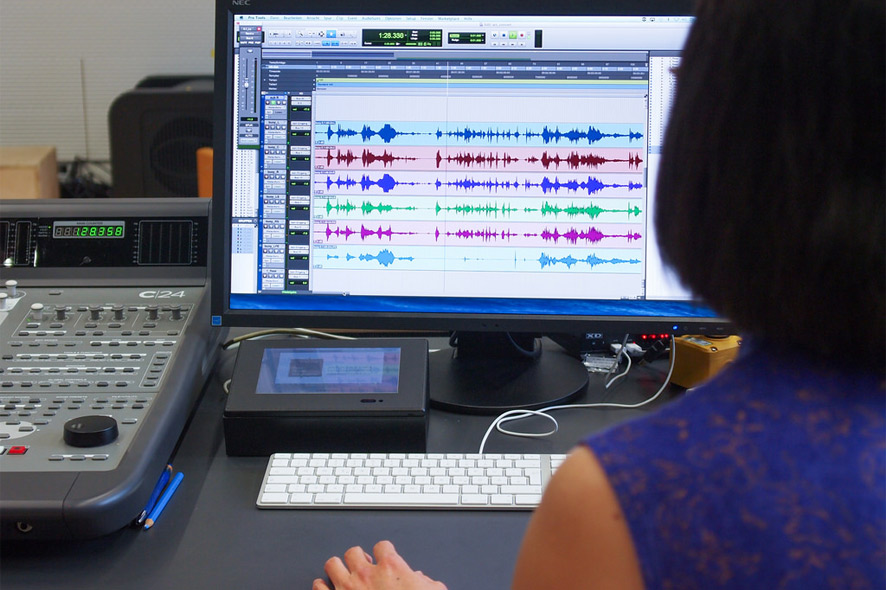
Computer music – music with the computer. Credit: Martin Hieslmair
How does the Computer Music Studio rate in comparison to other European institutions?
Volkmar Klien: Of course, there are comparable halls at several research facilities and universities worldwide. But there aren’t really that many that focus on this major field of research, on acoustic virtual realities. Up to now, multi-channel sound systems have been mostly confined to the commercial sector. The first version with a total of six channels was Dolby Surround 5.1 that was used in film production. The current Dolby Atmos System supports up to 64 loudspeakers. As far as I know, there’s only one studio in Austria licensed for this and only two movie theaters equipped with it. There are a lot of things happening here, but there’s no prevailing norm yet on how to handle this. And there are a lot of young artists interested in it.
Andreas Weixler: At international conferences, Eric Lyon and I and several others discussed networking among our respective computer music concert halls. The result is that CMS is one of the founding members the International Multichannel Music Consortium (IMMC) of spaces of this type. For example, there’s the UC Santa Barbara’s AlloSphere, a theater-like pavilion with a spherical shape. The BEAST at the University of Birmingham, on the other hand, is a “mobile” system of loudspeakers that can be installed at remote locations. Virginia Tech has set up a new hall with 128 loudspeakers, The CUBE. The University of Music and Performing Arts Graz has a Cube of its own, as well as a MUMUTH, a multi-channel computer music hall with a mobile, programmable loudspeaker system. There’s a HISS sound system at Huddersfield University, which was founded relatively recently and immediately made a name for itself worldwide. And, of course, the biggest names in this field are the Sonic Lab at Queen’s University in Belfast and the Klangdom at the ZKM–Center for Art and Media in Karlsruhe.
Volkmar Klien: And, naturally, there are numerous extramural efforts—some employing extremely simple means—to set up and control numerous loudspeakers at one location. There’s tremendous interest in spatial virtual sound and spatial interaction with sound.

Andreas Weixler at the production studio. Credit: Martin Hieslmair
What possibilities does the Sonic Lab offer?
Andreas Weixler: In addition to an instructional studio with eight channels, the production studio and the Sonic Lab (featuring a window between the performance area and the control room) offer the possibility of individually controlling 20 channels simultaneously. The quality of the sound is superb, but it depends upon what the artists do with it. This is a space for concerts, interactive situations, for teaching as well as experimentation and research on sound.
Chuang Se-Lien: Consider if you will spatial virtual sound. At the opening of the Sonic Lab last year, we presented a piece by John Chowning that had been recorded in Hagia Sophia in Istanbul. For the Sonic Lab performance, the loudspeakers were recalculated to precisely replicate the resonation time of the original venue.
Volkmar Klien: Here, the audience can truly be enwrapped in sound. You can experience concert situations in which there doesn’t have to be a front and rear. You can turn your head and let the sound waves sink in from all sides. It’s not like at a rock concert where the sound waves come from the front—of course, that’s nice too. What makes the Sonic Lab special is this experience of being surrounded by and enwrapped in sound.
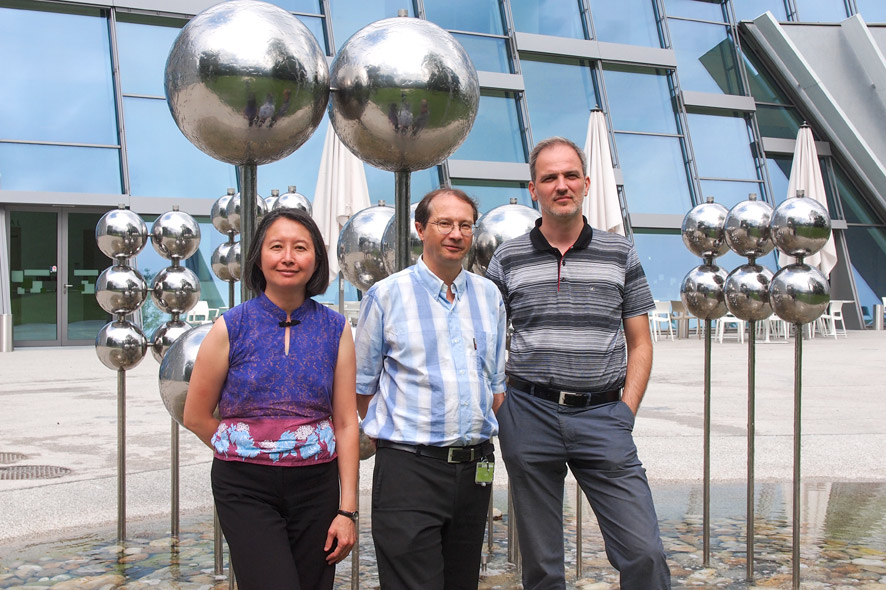
Chuang Se-Lien, Andreas Weixler and Volkmar Klien. Credit: Martin Hieslmair
Then the sound of the piano doesn’t necessarily come from the piano …
Volkmar Klien: The artistic possibility inherent in a space like this is the “liquefaction” of the boundary between a mechanical-acoustic instrument and the sound. You can actually create situations in which it isn’t completely clear where, for example, a piano is standing. You not only have the possibility of putting the audience amidst the sound; you can embed the instrumentalists in the sound as well. This is a parallel to media art—this “liquefaction” of the boundary between analog and digital, real and virtual. Computers are omnipresent, which makes them invisible and compounds their impact. Technologically speaking, these multi-channel setups aren’t such complex arrangements anymore. As soon as the technology itself is available and no longer constitutes such a challenge, then its social impact is heightened and it can also be formed artistically.

If it’s suddenly gets too loud – the emergency stop button. Credit: Martin Hieslmair
Chuang Se-Lien: Of course, a lot depends on the art project itself. The loudspeakers in Sonic Lab can be moved and adapted to the project; likewise, the audience members can be repositioned too. The possibilities in Sonic Lab are wide-ranging indeed. Since the space has been well made acoustically, the reflection of the sound of music created here is characterized by very high transparency. The realization of a tonal idea depends on the space but can nevertheless be very diverse. The sounds themselves and the temporal processes by which spatially transported sounds move through the loudspeakers are very meaningful manifestations and experiences for listeners’ sensory perceptions. An individual with trained hearing can still differentiate between acoustic instrumental sounds and those that have been digitally produced or processed. Here, not only the acoustic instruments, the loudspeakers and the computer come into play; this also entails the mixing console, and the various interfaces of the physical instruments that a skilled practitioner can use to achieve a unique, unmistakable result.
Andreas Weixler: This also has to do with the aspect of the extended instrument. It’s a great experience to see and hear action and reaction in an interactive performance. The artistry is that it’s always stimulating and thus keeps flowing; that when you believe you’ve understood something, something new comes along. Then again, when it’s so abstract and behind it all is a very sophisticated algorithm that computed what transpired over the previous 20 minutes, then it’s certainly ingenious from a mathematical point of view, but people can’t experience it. This interactivity and this interplay of experiencing and understanding and nevertheless having a few question marks remaining—this is the great experience that you have here with the augmented instrument.

The Kleine Saal at the University, Credit: Martin Hieslmair
What awaits Ars Electronica festivalgoers on Sonic Saturday?
Volkmar Klien: We’re presenting a very extensive program here at Anton Bruckner Private University’s Institute for Composition and Conducting on Saturday, September 10, 2016. Beginning at 2 PM, experts including Sabine Sanio of the UdK–Berlin University of the Arts and Thomas Gardner of London University of the Arts will convene for a symposium dealing with how areas of music, composition and sound art are interrelated and what sets them apart. After all, these areas are based on different contexts, have different theoretical structures and institutional framework conditions. As faculty members of a music university, we’re very interested in how to conceive of this interplay in our age of media. But the program isn’t only for experts; everyone is cordially invited to attend.
Andreas Weixler: On the evening of Sonic Saturday, festivalgoers will be able to experience immersive worlds of sound during a concert curated by Volkmar Klien, Se-Lien Chuang and me. Throughout the afternoon in the CMS production studio, guests can listen to current works in a 20.2-channel tonal arrangement. “Medium Sonorum,” the intermedial computer music concert that evening, will be staged in two halls—the Sonic Lab and the Kleiner Saal at the university, with its imposing organ and a loudspeaker system that makes it possible to simulate much greater spaces. The pieces on the program include Fernando Lopez-Lezcano’s “Kitchen <-> Miniature(s)” in which all the sounds are generated from kitchen noises and precisely adapted to the Sonic Lab’s loudspeaker system.
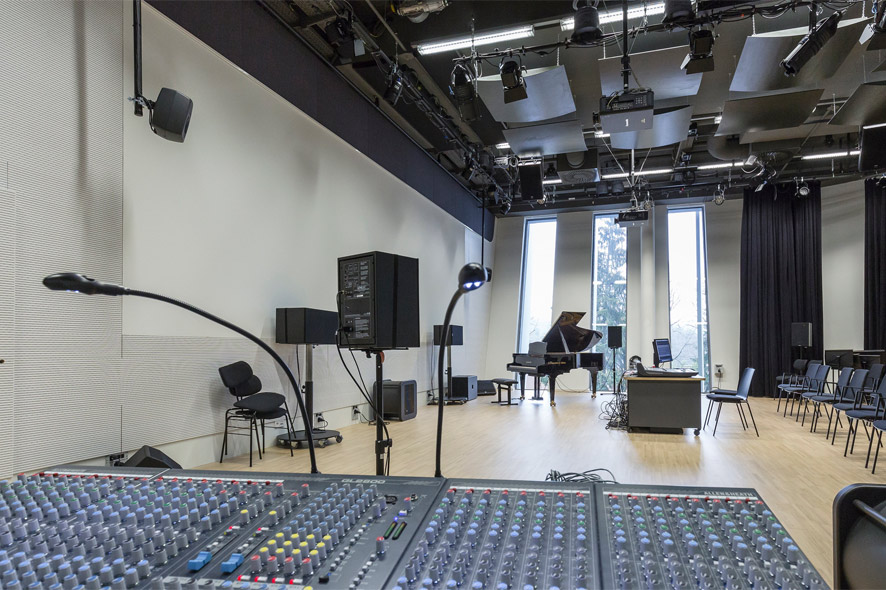
Credit: Christian Herzenberger
Chuang Se-Lien: Visuals and sound belong together, naturally. “Falling,” a lovely audiovisual piece by Italian composer Antonino Chiaramonte, will be accompanied by Adriano Cirulli’s visuals projected onto the Sonic Lab’s wall. In “The Special Treat – guided tour and short demo,” we’ll demonstrate audiovisual interactivity in the Sonic Lab with double projections in which the visual interactions are created in real time in accordance with the tonal events by means of a 20.4 loudspeaker system amidst the intermedial scene—in natura Medium Sonorum. We’ll also be presenting non-real-time and time-based pieces with audiovisual and electro-acoustic compositions that bring out the diverse characteristics of the various tonal landscapes of which Sonic Lab is capable. The tour also provides insights into the concept realized in the CMS’s premises with its production studio, teaching studio, and such spaces as the project room and the research room.
Andreas Weixler: “Self sustained circle,” a piece created by Michael Mayr in the Sonic Lab, deals with the delay of sound. “buoy” by David Berezan, a highly specialized composer of electro-acoustic music, “Assimilation” by Takuda Fukuda and featuring experienced bassist Margarethe Maierhofer-Lischka, and “Organ” by Veronika Mayer, which Theresa Zöpfl will perform live on that instrument, are the other highlights of this concert. Come and feast your ears!

The view over Linz from Anton Bruckner Private University. Credit: Martin Hieslmair

Volkmar Klien spent his childhood in Vienna, fascinated by musical life in that city with its glorious traditions and antiquated rituals. From this background, he now endeavors to expand the possibilities of composing, playing and listening far beyond classic concert situations. His interest in the multilayered interrelationships among various modes of human perception and the roles they play in the collaborative creation of reality has gotten him involved in a wide range of audible—and sometimes inaudible—artistry. His installation “Relative Realities” will run throughout the 2016 Ars Electronica Festival at the Mariendom [St. Mary’s Cathedral]. Volkmar Klien is Professor for Composition at Anton Bruckner Private University in Linz.
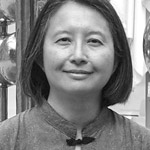
Se-Lien Chuang is a composer, pianist and media artist. She was born in 1965 in Taiwan and has lived in Austria since 1991. Her artistic work ranges from contemporary instrumental composition and improvisation, to computer music and electronic sound processing, all the way to audiovisual interactivity. She has studied composition (Beat Furrer), music & media technology (Karlheinz Essl), piano, the recorder and electro-acoustic music in Austria. Her international productions, research stays, speeches and numerous performances of her works have taken her throughout Europe as well as to Asia and North & South America, including: the Salzburg Festival, Wien Modern, Ultraschall Festival Berlin, ICMC Utrecht/Athens/Perth/Ljubljana/ Huddersfield/NYC/Belfast/Copenhagen, SICMF Seoul, NYCEMF, NIME Louisiana/New York City, ISEA Hong Kong/Singapore/Nagoya, IAMAS Japan, Ars Electronica Linz and the SONORITIES Festival Belfast.
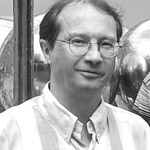
Andreas Weixler was born in 1963 in Graz. He’s a composer of contemporary instrumental and computer music with a particular emphasis on audiovisual interactivity, random virtuosity and interactive scores. He is a professor at Anton Bruckner Private University, where he initiated the development of the Computer Music Studio and the Sonic Lab, the intermedial multi-channel concert hall for computer music. He’s also an instructor at Linz Art University and University of Music and Performing Arts Vienna. Following his studies in Graz with Dobrowolski, Pagh-Paan and Furrer, he worked on numerous projects, studied abroad and performed research. Andreas Weixler launched the Intermedia concert series at the Ars Electronica Center Linz and operates (together with Se-Lien Chuang) the Atelier Avant Austria.
Music and Sounds at the 2016 Ars Electronica Festival
NOTE: At ars.electronica.art/radicalatoms you can peruse the entire Sonic Saturday program that will be presented on September 10th in conjunction with the Ars Electronica Festival. There are numerous offerings of great interest to music lovers on the festival program—concerts, performances, speeches and discussions. The Big Concert Night on September 11th in POSTCITY is another don’t-miss highlight. Deep Space 8K at the Ars Electronica Center is the spectacular setting of a series of audiovisual presentations as well as evening programs throughout the festival including the Opening, Nightline and OK Night. It has become a sort of tradition to make the final day of the Ars Electronica Festival Music Monday, an entire day dedicated to music and sounds. Speeches and presentations, performances, workshops and concerts will give insights into the sound projects & installations that will have been presented over the course of the festival. The prime venue of Music Monday is Anton Bruckner Private University.
